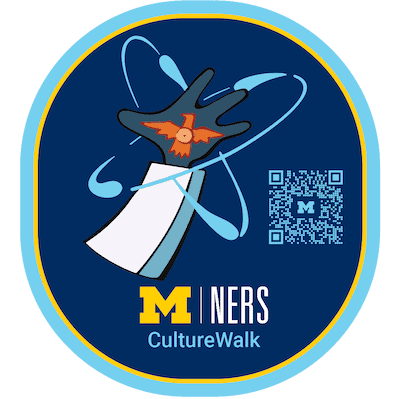
NERS Culture Walk
The NERS Culture Walk offers a unique glimpse into the heart of our department, celebrating the people, stories, and values that have shaped our community.
Whether you are a visitor, student, or faculty member, this walk provides an inspiring journey through the past, present, and future of NERS. Our self-guided tour invites visitors to discover key locations that embody our department’s history, values, and commitment to innovation at the intersection of art and science.

Look for this sticker on the floor in front of NERS Culture Walk locations.
The image was taken from the first iteration of the NERS Mural Project, and pays tribute to the Spirit of Detroit statue, which itself was created to note the importance of community to the City of Detroit.
Michigan Memorial Phoenix Project
Lobby Area
The Michigan Memorial Phoenix Project was established in the aftermath of World War II by University of Michigan students and faculty as a living memorial to those who lost their lives during the war. The project sought to harness atomic energy for peaceful purposes, symbolizing a rebirth from the ashes of war, much like the mythical Phoenix. Launched in 1948, it became the first university initiative globally to explore the peaceful uses of atomic energy, and over the years, it supported hundreds of groundbreaking projects, including a Nobel Prize-winning discovery.
The Phoenix Project also led to the creation of the Ford Nuclear Reactor and our department itself. Today, the project continues its mission through various initiatives, including the Fastest Path to Zero Initiative, aimed at achieving zero emissions through clean energy innovation. The building’s lobby houses several installations and memorials, offering visitors a space to pay tribute and reflect.
The Mural Tunnel
Tunnel Connecting the Cooley Building and the Phoenix Project
The NERS Mural, located in the tunnel connecting the Cooley Building and the Michigan Memorial Phoenix Project, stands as a vibrant testament to the synergy between art and science. This mural, designed by Michigan-based artist Devin J. Wright, visually represents the department’s rich history and the groundbreaking scientific work conducted here.
The project is integrated into the NERS 250: Introduction to Nuclear Engineering course, encouraging students to engage with the artistic process and offering a creative outlet that complements their rigorous academic pursuits. Throughout the process, students played a crucial role in shaping the mural. They completed questionnaires, participated in group discussions with Wright and Josh Rainer (also a Michigan-based artist), and voted on the final direction. Their active collaboration, including visualizing their ideas for the mural during concept development workshops, was invaluable to the design’s development.
The NERS Mural serves as a daily reminder of the intersection of creativity and innovation within the field of nuclear engineering, embodying the spirit of collaboration and the blending of art and science that defines the NERS department.
Listen: NERS Chair Todd Allen and Wright discuss the mural on U-M Creative Currents.
The Reclaimed Door
Cooley Building, Front Lobby
In the Cooley Building, a unique piece of art embodies the progress made by the women of NERS. The Reclaimed Door, once a symbol of the historical gender disparities within the field, has been transformed into a colorful, psychedelic art installation. This door, originally part of a notoriously narrow entrance to the first-floor women’s bathroom, now stands as a tribute to the strides made toward gender equality.
The transformation was led by the U-M Women in Nuclear Chapter, who held a “door-smashing party” to celebrate the installation of a new, appropriately sized door (the sledgehammer used to smash the door can be visited in the Cooley Front Office). Through a series of collaborative paint parties, the old door was reclaimed and turned into a vibrant symbol of the cultural revolution within the department. Generously funded by Gladys Knoll, the new door now serves as a gateway to opportunity, with every woman in the department encouraged to sign it. This growing tradition marks the declaration of NERS as a major, symbolizing the community’s commitment to supporting women and underrepresented backgrounds in nuclear engineering.